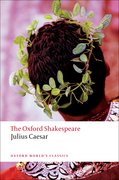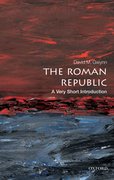 When we gaze back at the ancient world of the Roman Republic, what images are conjured in our minds? We see senators clad in togas, and marching Roman legions. The Carthaginian Hannibal leading his elephants over the Alps into Italy, Julius Caesar crossing the Rubicon and his murder on the Ides of March. These images are kept fresh by novels and comic books, and by television series like Rome and Spartacus: Blood and Sand. Nor are we the first to seek inspiration in Republican Rome. The last years of the Republic gave life to two of Shakespeare’s most compelling plays, Julius Caesar and Antony and Cleopatra, and perhaps the most famous speech in the Shakespearean canon (‘Friends! Romans! Countrymen! Lend me your ears’). The Founding Fathers of the United States of America took Rome as their model in drafting the US Constitution, while the French Revolution drew upon the same ideals with dramatically different results. Across two thousand years, each passing generation has turned to the Roman Republic in search of lessons to apply to their own times.
When we gaze back at the ancient world of the Roman Republic, what images are conjured in our minds? We see senators clad in togas, and marching Roman legions. The Carthaginian Hannibal leading his elephants over the Alps into Italy, Julius Caesar crossing the Rubicon and his murder on the Ides of March. These images are kept fresh by novels and comic books, and by television series like Rome and Spartacus: Blood and Sand. Nor are we the first to seek inspiration in Republican Rome. The last years of the Republic gave life to two of Shakespeare’s most compelling plays, Julius Caesar and Antony and Cleopatra, and perhaps the most famous speech in the Shakespearean canon (‘Friends! Romans! Countrymen! Lend me your ears’). The Founding Fathers of the United States of America took Rome as their model in drafting the US Constitution, while the French Revolution drew upon the same ideals with dramatically different results. Across two thousand years, each passing generation has turned to the Roman Republic in search of lessons to apply to their own times.
At the heart of history’s fascination with the Roman Republic lies a paradox. After the expulsion of the last of its legendary seven kings in 510 BC, Rome evolved a unique constitution intended to prevent any return to tyrannical autocracy. Power was shared between the elected magistrates who ran the daily business of government, the popular assemblies which conducted elections and approved laws, and the Senate which debated all major decisions and was in effect the Republic’s ruling body. The result was a stable, conservative, but adaptable form of government that far surpassed the city-states of contemporary Greece. The Republic wasn’t a democracy and far less vulnerable to popular whims than classical Athens, and possessed a practical flexibility that the equally militaristic Spartans lacked. On the battlefield the Roman legion in turn superseded the Greek phalanx, and one by one Rome defeated Carthage and the Hellenistic successors to Alexander the Great. When we think of conquering Roman legions we tend to think of the Roman Empire, but it was the Republic that brought the Mediterranean under Roman rule.
Yet this juggernaut, the most powerful state that the ancient world had ever known, collapsed under the burden of its own success. The fall of the Republic was not due to external attack, for no enemy remained that posed a serious threat to Rome. On the contrary, the Republic’s collapse was driven by the same forces that underlay its triumph. The senatorial aristocracy who dominated Republican life competed from birth for prestige and to surpass the achievements of their ancestors. Desire for dignitas and gloria, the cardinal values of the Roman elite, became ever greater as Rome expanded and the stakes of competition increased. At the same time, the vast wealth amassed through Rome’s conquests brought social and economic crisis that gave ambitious nobles new opportunities. Warlords commanding private armies duelled for supremacy, from Gaius Marius and Cornelius Sulla to Pompeius Magnus and Julius Caesar, and the Republic disintegrated into chaos and civil war.
 Like all great historical epics, the Republic’s fall was not a story of inevitable or irreversible decline. Republican champions sought to turn back the tide. The Gracchi brothers aspired to social and economic reform, and were murdered for their pains. Cicero raised Roman oratory and philosophy to new heights and offered moral guidance to restore stability to the Republic, although in his priceless letters he reveals a more personal and at times vindictive side (‘How I should like you to have invited me to that most gorgeous banquet on the Ides of March’). Ambition and desire for power, however, proved too strong. Julius Caesar took the title dictator after defeating Pompeius Magnus, and Caesar’s murder by Brutus and the ‘Liberators’ in 44 BC merely plunged Rome into another decade of conflict. Finally, Caesar’s adopted son Gaius Julius Caesar Octavianus defeated Marcus Antonius and Cleopatra at Actium in 31 BC, and four years later took the name Augustus. The Roman Republic, a state whose very raison d’être had been to prevent autocracy, had given way to the Roman Empire.
Like all great historical epics, the Republic’s fall was not a story of inevitable or irreversible decline. Republican champions sought to turn back the tide. The Gracchi brothers aspired to social and economic reform, and were murdered for their pains. Cicero raised Roman oratory and philosophy to new heights and offered moral guidance to restore stability to the Republic, although in his priceless letters he reveals a more personal and at times vindictive side (‘How I should like you to have invited me to that most gorgeous banquet on the Ides of March’). Ambition and desire for power, however, proved too strong. Julius Caesar took the title dictator after defeating Pompeius Magnus, and Caesar’s murder by Brutus and the ‘Liberators’ in 44 BC merely plunged Rome into another decade of conflict. Finally, Caesar’s adopted son Gaius Julius Caesar Octavianus defeated Marcus Antonius and Cleopatra at Actium in 31 BC, and four years later took the name Augustus. The Roman Republic, a state whose very raison d’être had been to prevent autocracy, had given way to the Roman Empire.
In the modern world where change comes ever more rapidly, it is hardly surprising that our attention is drawn above all to the drama of the Republic’s final years. But there was more to the Republic than senators and legions. To understand ancient Rome we need to look deeper: at the women whose crucial roles our male-dominated sources conceal, at the slaves upon whose labour Roman society depended, at the religious values and customs that defined what being Roman meant. Popular culture no less than academic scholarship can play an essential role in bringing the Roman Republic to life, and in doing so allow us to seek our own lessons from the triumphs and tragedies of the Republic and Rome’s transformation into Empire.



[…] A quick introduction to the history of the Roman Republic, in case you missed (or misplaced your notes for) Kevin Cragg’s Roman Civilization […]